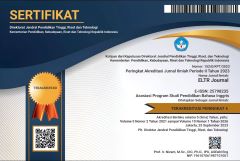THE USE OF BREAKOUT ROOMS DISCUSSION IN JIGSAW ONLINE LEARNING CLASS: DEVELOPING CREATIVITY AND INCREASING STUDENT ENGAGEMENT
Abstrak terlihat: 903 / PDF terunduh: 543DOI:
https://doi.org/10.37147/eltr.v6i2.149Keywords:
Jigsaw Strategy, Cooperative learning, Breakout Zoom, Students Creativity EngagementAbstract
This study investigates the use of breakout rooms discussion in jigsaw online learning class on developing creativity and increasing student engagement. The reason for establishing this study is how the Breakout Rooms meeting application is suitable for use for the application of the cooperative method learning. This study used a qualitative descriptive research method to collect data from a Likert scale questionnaire ranging from 1 (strongly disagree) to 5 (strongly agree). The research subjects were drawn from a group of college EFL students. This study shows that out of 15 EFL students, The results of participant’ Google forms perceptions about Jigsaw Strategy encourages work together became cooperative learning, showed the response rates of Strongly Agree (SA) 16%, Agree (A) 80%, Neutral (N) 16%, Disagree (D) 8%, and Strongly Disagree (SD) 0%. Meanwhile, the results about breakout rooms on zoom increasing potential of student to be effective as learning media rate of Strongly Agree (SA) 12%, Agree (A) 80%, Neutral (N) 8%, Disagree (D) 0% and Strongly Disagree (SD) 0%. Furthermore the results about students are motivated with Jigsaw Strategy Strongly Agree (SA) 4%, Agree (A) 88% & Neutral (N) 4%, Disagree (D) 4% as well as Strongly Disagree (SD) 0%.
Downloads
References
Alfadda, H. A., & Mahdi, H. S. (2021). Measuring students’ use of Zoom application in language course based on the technology acceptance model (TAM). Journal of Psycholinguistic Research, 50, 883–900.
Alim, J. A., Fauzan, F., Arnawa, I. M., & Musdi, E. (2020). Pengembangan model pembelajaran realistik geometri (PRG) berbantuan multimedia interaktif. (Unpublished Dissertation, UNP).
Amalia, D. F. (2020). Quizizz website as an online assessment for English teaching and learning: Students’ perspectives. Jo-ELT (Journal of English Language Teaching) Fakultas Pendidikan Bahasa & Seni Prodi Pendidikan Bahasa Inggris IKIP, 7(1), 1–8.
Bonwell, C. C. & Eison, J. A. (1991). Active learning: Creating excitement in the classroom. ASHE-ERIC Higher Education Report 1. Washington: George Washington University.
Cohan, L., Manion, L., & Morrison, K. (2007). Research methods in education (6th Ed.). London and New York, NY: Routledge.
Ellingson, D. A., & Notbohm, M. (2012). Synchronous distance education: Using web conferencing in an MBA accounting course. American Journal of Business, Education, 5(5), 555–562.
Haqien, D., & Rahman, A. A. (Agustus 2020). Pemanfaatan Zoom meeting untuk proses pembelajaran pada masa pandemi Covid-19. SAP (Susunan Artikel Pendidikan), 5(1). http://dx.doi.org/10.30998/sap.v5i1.6511
Hythecker, V. I., Dansereau, D. F., & Rocklin, T. R. (1988). An analysis of the processes influencing the structured dyadic learning environment. Educational Psychologist, 23, 23-37.
Johnson, D. W., & Johnson, R. T. (1995). Cooperation and the use of technology. In D. Jonassen (Ed.), Handbook of research for educational communications and technology (pp. 1017-1044). New York: Macmillan Libra1ry.
Fadilah, R. &. (2021). Microsoft team of Zoom as a media for teaching extensive reading during Covid 19 pandemic. INCARE, 01(06).
Fink, D. L. (2003). Creating significant learning experiences: An integrated approach to designing college courses. San Francisco: Jossey-Bass.
Nahar, N. I. (2016). Penerapan teori belajar behavioristik dalam proses pembelajaran. NUSANTARA Jurnal Ilmu Pengetahuan Sosial, 1(1), 64-74.
Martin, F., & Parker, M. A. (2014). Use of synchronous virtual classrooms: Why, who, and how? Journal of Online Learning and Teaching, 10(2), 192–210.
Moore, M. J. (1993). Three types of interaction. In K. Harry, M. John, & D. Keegan (Eds.). Distance education theory (pp. 19–24). Routledge.
Redish, E., Saul, J., & Steinberg, R. (1997). On the effectiveness of active-engagement microcomputer-based laboratories. American Journal of Physics, 65(1), 45.
Sepulveda-Escobar, P., & Morrison, A. (2020). Online teaching placement during the COVID-19 pandemic in Chile: challenges and opportunities. European Journal of Teacher Education, 43(4), 587-607. https://www.tandfonline.com/doi/abs/10.1080/02619768.2020.1820981
Nurjati, S. (2002). Bab II pembelajaran akidah akhlak. Basis Humansitik, Pendekatan Active Learning (pp. 39–104).
Simamora, R. M. (2020). The challenges of online learning during the Covid-19 pandemic: An essay analysis of performing arts education students. Studies in Learning and Teaching, 1(2), 86-103. https://scie-journal.com/index.php/SiLeT/article/view/38
Sumintono, B., & Widhiarso, W. (2015). Aplikasi pemodelan Rasch pada asesmen pendidikan. Trim Komunikata.
Tan, G., P. B. Gallo, G. M. Jacobs., & C.K.E, Lee. (1998). Using cooperative learning to integrate thinking and information technology in a content-based writing lesson. Paper Presented at Singapore Educational Research Association, Singapore, November, 1998.
Webb, M. D. (1992). The effects of the Jigsaw cooperative learning technique on racial attitudes and academic achievement (Doctoral dissertation, California State University, Fresno, 1988).
Widiyani, S. P. (2021, Maret). Optimalisasi kemampuan berbicara Bahasa Inggris dan percaya diri melalui Jigsaw pada siswa kelas X SMK. Jurnal Pendidikan: Teori, Penelitian, dan Pengembangan, 6(3), 339—344
Downloads
Published
How to Cite
Issue
Section
License
Copyright (c) 2022 Hirdina Amelia, Rolisda Yosintha

This work is licensed under a Creative Commons Attribution-ShareAlike 4.0 International License.













